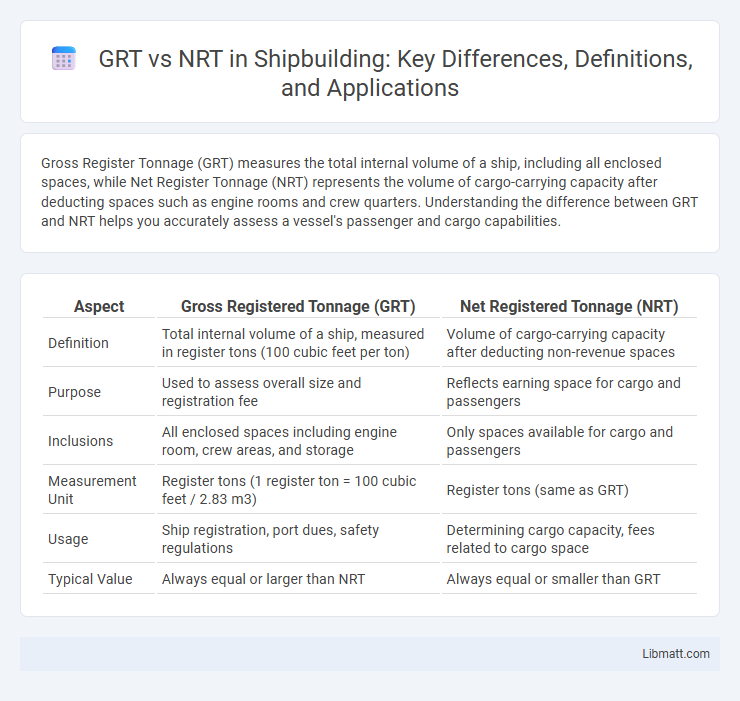Gross Register Tonnage (GRT) measures the total internal volume of a ship, including all enclosed spaces, while Net Register Tonnage (NRT) represents the volume of cargo-carrying capacity after deducting spaces such as engine rooms and crew quarters. Understanding the difference between GRT and NRT helps you accurately assess a vessel's passenger and cargo capabilities.
Table of Comparison
| Aspect | Gross Registered Tonnage (GRT) | Net Registered Tonnage (NRT) |
|---|---|---|
| Definition | Total internal volume of a ship, measured in register tons (100 cubic feet per ton) | Volume of cargo-carrying capacity after deducting non-revenue spaces |
| Purpose | Used to assess overall size and registration fee | Reflects earning space for cargo and passengers |
| Inclusions | All enclosed spaces including engine room, crew areas, and storage | Only spaces available for cargo and passengers |
| Measurement Unit | Register tons (1 register ton = 100 cubic feet / 2.83 m3) | Register tons (same as GRT) |
| Usage | Ship registration, port dues, safety regulations | Determining cargo capacity, fees related to cargo space |
| Typical Value | Always equal or larger than NRT | Always equal or smaller than GRT |
Introduction to GRT and NRT
Gross Register Tonnage (GRT) measures the total internal volume of a ship's enclosed spaces, expressed in register tons where one register ton equals 100 cubic feet. Net Register Tonnage (NRT) represents the volume of cargo-carrying capacity, calculated by deducting spaces unavailable for cargo, such as crew areas and machinery spaces, from the GRT. Understanding the distinction between GRT and NRT helps you accurately assess a vessel's carrying potential and regulatory requirements.
Defining GRT: Principles and Applications
Gross Register Tonnage (GRT) measures the total internal volume of a vessel's enclosed spaces, expressed in register tons where one register ton equals 100 cubic feet. It serves as a crucial metric for determining port fees, safety regulations, and ship registration requirements by reflecting the overall size of the ship rather than its cargo capacity. GRT's application encompasses assessing ship design efficiency and regulatory compliance within maritime operations.
What is NRT? Core Concepts and Uses
Net Register Tonnage (NRT) measures the usable volume of a ship's cargo and passenger spaces, excluding areas like engine rooms and crew quarters. This metric helps determine fees, port charges, and regulatory compliance based on the ship's earning capacity. Understanding NRT is essential for managing your vessel's operational efficiency and costs effectively.
Key Differences Between GRT and NRT
Gross Register Tonnage (GRT) measures a ship's total internal volume, including all enclosed spaces, while Net Register Tonnage (NRT) accounts only for the cargo-carrying capacity by subtracting spaces used for machinery and crew. GRT is primarily used for port fees and regulations, whereas NRT is crucial for assessing earning potential and cargo space. Understanding these key differences helps you accurately evaluate a vessel's operational and financial capabilities.
Methodologies: How GRT and NRT Work
Gross Register Tonnage (GRT) measures the total internal volume of a vessel, including all enclosed spaces, using a standardized calculation based on the ship's dimensions. Net Register Tonnage (NRT) subtracts non-revenue-earning spaces such as engine rooms and crew quarters from the GRT to reflect the vessel's cargo-carrying capacity more accurately. Understanding these methodologies helps you assess a ship's size and earning potential through volume rather than weight.
Benefits of Using GRT
Gross Register Tonnage (GRT) measures the total internal volume of a vessel, providing a more comprehensive understanding of ship size compared to Net Register Tonnage (NRT), which focuses solely on cargo-carrying capacity. Using GRT offers benefits such as more accurate assessments for port fees, safety regulations, and stability calculations crucial for voyage planning. By focusing on GRT, you gain clearer insights into ship capacity and operational costs beyond cargo limits.
Advantages of NRT in Practice
Net Register Tonnage (NRT) offers practical advantages by providing a clearer measure of a ship's usable cargo and passenger space, enabling more accurate fee calculation and regulatory compliance. Unlike Gross Register Tonnage (GRT), which includes all internal volume, NRT excludes non-revenue spaces such as engine rooms and crew quarters, aligning charges more closely with actual earning capacity. Your shipping operations benefit from NRT's focus on revenue-generating space, optimizing cost-efficiency and operational planning.
Challenges and Limitations of GRT & NRT
Gross register tonnage (GRT) and net register tonnage (NRT) face challenges in accurately reflecting a vessel's cargo capacity due to outdated measurement standards rooted in ship volume rather than weight or actual cargo space. GRT overestimates space by including all enclosed spaces, while NRT attempts to exclude non-revenue spaces but can still misrepresent usable capacity, complicating port fee calculations and regulatory compliance. Both metrics lack precision for modern vessels with complex layouts, leading to limitations in fair taxation and operational assessments.
Real-World Examples and Case Studies
GRT (Gross Register Tonnage) and NRT (Net Register Tonnage) play crucial roles in maritime shipping, impacting vessel registration, port fees, and regulatory compliance. For instance, the container ship MSC Zoe's GRT determines its size for harbor entry, while its NRT influences cargo capacity calculations and storage fees. Your understanding of these metrics can optimize shipping logistics and cost management in real-world scenarios such as cargo transport and fleet operations.
Conclusion: Choosing Between GRT and NRT
Choosing between Gross Register Tonnage (GRT) and Net Register Tonnage (NRT) depends on the shipping context and your specific needs. GRT measures the total internal volume of a vessel, including all enclosed spaces, making it ideal for assessing overall ship size. NRT excludes non-revenue spaces like engine rooms, focusing on the ship's earning capacity, which is crucial for freight calculations and operational planning.
GRT vs NRT Infographic

 libmatt.com
libmatt.com